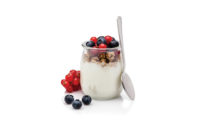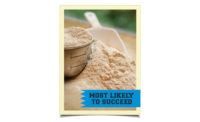Dairy ingredients: Navigating the world of flavors
Ethnic influences like elote (Mexican corn on the cob) and Moroccan spices are finding a place in dairy foods.


Hazelnuts and chocolate are the ingredients in Star Kay White’s Hazelnut Hash product. Photos courtesy of Star Kay White

Cookies and cream are a classic pairing. Today’s flavor houses are exploring more exotic mashups, like peanut butter, honey and cinnamon, and maple-caramel swirls with maple sugar pieces for a French toast flavor.

Chocolate is hard to work with because it tends to have ashy, smoky, earthy notes that don’t pair well with notes in dairy, says one flavor supplier. Photo courtesy of Star Kay White




After what feels like decades of straining to eat virtuously, the backlash has arrived in the form of a generalized weariness with the whole notion of “good for you.” How else to explain the success of foodservice stunts like the Pop-Tart ice cream sandwich from hamburger purveyor Carl’s Jr., or Taco Bell’s successful-beyond-belief Doritos Locos Taco?
But most Americans aren’t aiming to ditch their diets entirely and start counting strawberry gelato as a fruit serving. We just want the nutritional equivalent of a three-day weekend from the task of minding our fats, carbs and calories. Thus, it is welcome news that we need travel no farther than the dairy aisle to partake of such a holiday. That’s because dairy has long been the domain of decadence, albeit with a wholesome backbone. And now more than ever, flavor houses are conjuring up cup-runneth-over profiles that give even good-for-you dairy a deliciously sinful twist. We say it’s about time.
Indulgent immersion
Dairy’s return to decadence doesn’t surprise Don Heffner, director of sales for Star Kay White, Congers, N.Y. He and his colleagues have been immersing themselves in indulgence for a while, “especially where it intersects with other important consumer trends,” he said.
For example, the company’s newly hired corporate chef, Catherin Felix — whose resume includes stints at Häagen-Dazs and Good Humor Breyers — has been working with R&D and other creative employees to develop products that rope in everything from international inspiration to tempting textures. A case in point is a textured cinnamon-churro variegate embedded in chocolate ice cream.
The variegate “stays crunchy and consistent with the texture of a churro throughout the shelf life of the product,” Heffner said, and gives a nod to the growing influence of Latino cuisines — and consumers.
Another concept — the brainchild of Ameena Cohen, account sales manager, and Marylyn Eichenholz, a 27-year veteran of Star Kay White’s R&D department — brings indulgence to breakfast (or breakfast to the ice-cream case, depending on how you look at it). It’s a French toast trio that adds maple-caramel swirls and maple-sugar pieces to ice cream with a French-toast flavor.
Other innovative flavors that have Heffner and his colleagues excited include the company’s new sesame brittle product and its Hazelnut Hash, which combines chocolate and hazelnut.
Around the world in 80 flavors
“Developers are looking for indulgence and excitement. That requires us to get out of the box when we put together flavors,” Heffner said.
Getting out of the box also often involves going on a world tour of culinary inspiration. Not only do international flavors lay the groundwork for creations like Star Kay White’s churro concept, they satisfy our yearning for sensory exploration.
“With consumers willing to be more adventurous in their food selections and the growing demand for ethnic authenticity, there is a trend emerging for exotic tastes from abroad,” even in the dairy aisle, said Marketing Manager Azeem Mateen of Sensient Flavors, Hoffman Estates, Ill.
He credits Hispanic cuisines’ use of “authentic spices, cheeses and vegetables as fundamental culinary ingredients” with inspiring his team’s elote-flavored ice cream. Elote, a Mexican street food, is a grilled corncob topped with spices and seasonings. Sensient’s frozen-dairy version is sweet-corn-flavored ice cream studded with corn kernels and swirled with a blend of Parmesan, cilantro, chili powder and lime.
As far as other international influences are concerned, Becky Wagner, business unit manager for Fona International, Geneva, Ill., puts her money on Moroccan spices as the next ethnic wave to wash over dairy, sweet or savory.
“The blend of warm spices delivered via various dairy products seems like an interesting innovation,” she said. So, too, are the Italian cannoli and tiramisu profiles that she and colleagues have noticed in yogurts, as well as the taco, tzatziki and curry flavors they’ve seen in savory Greek-style yogurt dips.
Monster mashups
Adding a curry note to yogurt and dressing ice cream in a French-toast disguise are other ways of creating a “mashup,” the term for the increasingly common freestyle fusions that cross concepts with categories in ways that Mother Nature (to say nothing of Marketing) never intended. But in the minds and on the palates of today’s dairy shoppers, such hybrids are all part of the fun.
“As consumers grow bolder in their taste profiles, we expect to see more ‘mashup’ combinations,” Mateen said.
Other concepts from Sensient Flavors are a glazed-donut-flavored yogurt paired with a raspberry side compartment, and yogurt with a banana-split fruit base and a chocolate-syrup side compartment.
Jon Vander Woude, director of marketing at Denali Flavors, Wayland, Mich., is no stranger to the mashup culture. He points to Denali’s combination of peanut butter, honey and cinnamon (called Peanut Butter Honey Cinn-sation). He also noted that the company plans to mash up its signature Moose Tracks ice cream with peppermint for the winter holidays.
Classics 2.0
Anita Gonzales, applications technician at Fona, sees successful mashups as “extensions of the classics.” In other words, “Customers are still looking for classics like vanilla and strawberry, but they’re putting an indulgent twist on them,” she said. Instead of vanilla there’s vanilla latte and plain strawberry yields to strawberry cheesecake.
And while adding peppermint bark to ice cream or a donut glaze to yogurt is novel, it’s not as much of a conceptual stretch as bringing the classic cocktail trend to dairy. But that may be the next trend to come over the horizon. After all, notes Anton Angelich, group vice president of marketing, Virginia Dare, Brooklyn, N.Y., with “Mad Men”-era tipples like sidecars, gimlets and old fashioneds hipper than ever, “this just might migrate to some indulgent foodservice dairy dessert products.”
Getting the profile right
We can only hope. Wagner called cross-category dairy mashups “a great idea” but warned that a fine line separates those that click from those that clash — or that simply fail to convey the concept at all.
“Consumers are looking for products that deliver on the product’s title,” Wagner says. “So a s’mores smoothie may be a great idea, but it has to have all the essential components represented in the product’s flavor delivery,” from graham notes and toasted marshmallow to chocolate.
By a similar token, said Angelich, a convincing pie profile for yogurt requires “adding piecrust, pastry, graham cracker, buttery, baking spice and crumble notes.”
Then there are other technical matters to consider when formulating mashup indulgence into dairy. Factors like fat content, eating temperature, sweetener system and processing all influence the composition and performance mandates of the flavor system. That’s why finding an ingredient system that can hybridize myriad sensory realms is never as easy as plugging in an off-the-shelf flavor.
Said Wagner, “Flavor solutions differ depending on the end product. The same flavor will present very differently in different product bases.”
How so? Consider that dairy products possess lactone, bitter, slightly sour and fatty notes.
“Certain flavors have profiles that don’t mesh with that sort of makeup.” Gonzales said. And believe it or not, chocolate is one of them.
“Chocolate is hard to work with because it tends to have ashy, smoky, earthy notes that don’t pair well with notes in dairy,” Gonzales explained.
Grapefruit also poses challenges, particularly in creamy, fatty, high-lactone dairy items where its tart, sulfury and astringent qualities stick out.
When dairy products are tart themselves — as is the case with yogurt — they can be difficult to pair with some profiles, too — and again, chocolate is among them.
As Angelich said, “Chocolate tastes are characteristically alkaline, and yogurt is acidic. When you combine the two, you often end up with something that tastes like neither.” This is no small matter given the “plethora of great-tasting chocolates and chocolate-containing products” consumers now have at their disposal, he said. “Thus, their standards and expectations are very high.”
Adam Schowalter, flavorist in training at Fona, underscored the role that eating conditions play in shaping our perceptions of dairy flavor. “The temperature at consumption will affect how the flavor releases and tastes, and we take this into consideration when screening and testing flavors,” he said.
Texture and mouthfeel are also important to pulling off the illusion of full fat or full sugar in dairy items with lower levels of these ingredients, he said. In such better-for-you applications, flavor modifiers designed specifically to conjure the perception of fat and sugar can provide the solution.
If you’re wondering whether consumers will accept an over-the-top flavor profile in a virtuously “healthy” dairy product, Angelich insists they will, if the profile and product are compatible.
“Our consumer research has indicated that indulgent flavors like tiramisu, devil’s food cake, red velvet cake and chocolate-chip cookie may not fit conceptually with some health-and-wellness foods and beverages,” he said. But, consumers are looking for healthy fortified products, such as protein shakes and smoothies “and they’ll accept a classic chocolate taste in these products,” he said.
Indeed, decadence is back by popular demand.
“The supermarket is a buyer’s market,” Angelich pointed out. “Consumers want to have their cake and eat it, too. Yes, they’re looking for healthy and nutritious foods, but those foods have to taste great, too.”
Looking for a reprint of this article?
From high-res PDFs to custom plaques, order your copy today!











